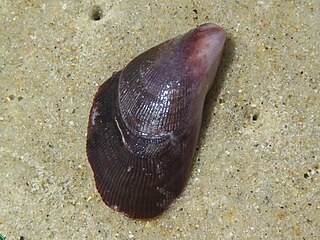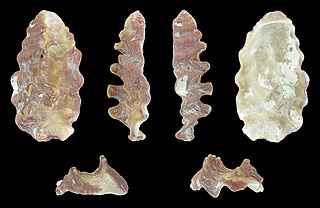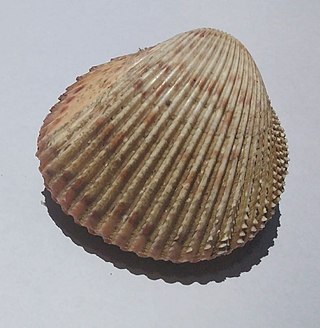
The Lesser Antilles are a group of islands in the Caribbean Sea. Most of them are part of a long, partially volcanic island arc between the Greater Antilles to the north-west and the continent of South America. The islands of the Lesser Antilles form the eastern boundary of the Caribbean Sea where it meets the Atlantic Ocean. Together, the Lesser Antilles and the Greater Antilles make up the Antilles. The Lesser and Greater Antilles, together with the Lucayan Archipelago, are collectively known as the West Indies.

The West Indies is a subregion of North America, surrounded by the North Atlantic Ocean and the Caribbean Sea, which comprises 13 independent island countries and 18 dependencies in three archipelagos: the Greater Antilles, the Lesser Antilles, and the Lucayan Archipelago.
Nuculana acuta, or the pointed nut clam, is a marine bivalve mollusc in the family Nuculanidae. It can be found along the Atlantic coast of North America, ranging from Massachusetts to Texas, including the West Indies.

Arca imbricata, or the Mossy ark clam, is a clam in the family Arcidae. It can be found along the Atlantic coast of North America, ranging from North Carolina to the West Indies, Brazil, and Bermuda.

Barbatia candida, or the White-bearded ark clam, is a clam in the family Arcidae. It can be found along the Atlantic coast of North America, ranging from North Carolina to Texas, including the West Indies.

Lunarca ovalis, also known as the blood ark clam, is a species of clam in the family Arcidae. It can be found along North America coast of the Atlantic Ocean, ranging from Massachusetts to the West Indies and Brazil. It resides from the low-tide line to a depth of ten feet.

Anadara transversa, or the Transverse ark clam, is a clam in the family Arcidae. It can be found along the Atlantic coast of North America, ranging from Massachusetts to Texas, including the West Indies.

Glycymeris undata, or the Atlantic bittersweet, is a species of bivalve mollusc in the family Glycymerididae. It can be found along the Atlantic coast of North America, ranging from North Carolina to the West Indies and Brazil.

Brachidontes exustus, commonly known as the scorched mussel, is a species of bivalve mollusc in the family Mytilidae. It can be found along the Atlantic coast of North America, ranging from Cape Hatteras to the West Indies and Brazil.
Musculus lateralis, common name the Lateral mussel, is a small species of bivalve mollusc in the family Mytilidae. It can be found along the Atlantic coast of North America, ranging from North Carolina to the West Indies and Brazil.

Botula fusca, or the Cinnamon mussel, is a species of bivalve mollusc in the family Mytilidae. It can be found along the Atlantic coast of North America, ranging from North Carolina to the West Indies and Bermuda.
Lithophaga nigra, or the Black date mussel, is a species of bivalve mollusc in the family Mytilidae. It can be found along the Atlantic coast of North America, ranging from southern Florida to the West Indies.

Atrina serrata, or saw-toothed pen shell, is a species of bivalve mollusc in the family Pinnidae. It can be found along the Atlantic coast of North America, ranging from North Carolina to Texas and the West Indies.

Dendostrea frons, the frond oyster, is a species of bivalve mollusc in the family Ostreidae.
Ostrea permollis, the sponge oyster, is a species of bivalve mollusc in the family Ostreidae. It can be found along the Atlantic Coast of North America, ranging from North Carolina to the West Indies.
Diplodonta punctata, or the Atlantic diplodon, is a species of bivalve mollusc in the family Ungulinidae. It can be found along the Atlantic coast of North America, ranging from North Carolina to the West Indies and Bermuda.

Chama macerophylla, or the leafy jewel box clam,
is a species of bivalve mollusc in the family Chamidae.

Trachycardium isocardia, the West Indian prickly cockle, is a species of bivalve mollusc in the family Cardiidae. It can be found along coast of the West Indies.

Dallocardia muricata, the yellow cockle, is a species of bivalve mollusc in the family Cardiidae. It can be found along the Atlantic coast of North America, ranging from North Carolina to the West Indies and Brazil.
Americardia media, the Atlantic strawberry cockle, is a species of saltwater clam, a marine bivalve mollusc in the family Cardiidae, the cockles. This species can be found along the Atlantic coast of North America, from Cape Hatteras to the West Indies.














